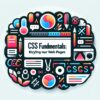Understanding the Basics of HTML: Your First Step in Web Development

Introduction
Embarking on a journey to become a web developer is an exciting endeavor that opens up a world of creative and technical possibilities. At the foundational level of this vast field lies HTML, or HyperText Markup Language, the cornerstone of the internet. Understanding HTML is imperative for anyone aspiring to develop websites or web applications. This article aims to demystify the basics of HTML, guiding you through your very first step in web development.
What is HTML?
HTML stands for HyperText Markup Language. It is not a programming language but a markup language that dictates the structure of web pages. HTML uses various tags to organize and format content on the web, making it readable and accessible. Everything from paragraphs and links to images and tables can be created using HTML. It serves as the skeleton of all websites, providing a basic layout before CSS (Cascading Style Sheets) and JavaScript enhance its appearance and functionality.
Why HTML is Essential
– Foundation of Web Development: HTML is the starting point for web development. A profound understanding of HTML is crucial for advancing in other web technologies.
– SEO Optimization: Proper use of HTML tags ensures better search engine rankings. Semantic HTML5 introduces meaningful tags that help search engines understand the content structure, boosting SEO efforts.
– Cross-platform Compatibility: HTML is universally supported across all web browsers and devices, ensuring your content is accessible to a broad audience.
Understanding HTML Structure
At its core, an HTML document is structured between the ;<html>> opening tag and the ;</html>> closing tag, with the content divided into the head (;<head></head>>) and body (;<body></body>>) sections. The head section contains meta-information about the document, while the body section houses the content visible to users.
Basic HTML Document Template
This is your first paragraph.
</body> </html>Key HTML Tags and Their Uses
– ;<h1>> to ;<h6>>: These tags represent headings, with ;<h1>> being the most important or main heading and ;<h6>> the least. Use them to structure your content hierarchically. >
– ;
– </strong>;<a>><strong>: The anchor tag is used to create hyperlinks that connect one page to another.
– </strong>;<img>>: Embed images in your HTML using this tag. Remember to specify the ;src> (source) attribute to point to the image location.
– ;<ul>>, ;<ol>>, ;<li>>: Unordered (;<ul>>) and ordered (;<ol>>) lists are created with these tags, with ;<li>> marking each item in the list.
– ;<div>>: Acts as a container for other HTML elements, helpful in layout and styling with CSS.
Conclusion
Understanding the basics of HTML is the first critical step in the journey to becoming a web developer. It lays the groundwork for further learning and mastery of web technologies like CSS, JavaScript, and PHP. By grasping the structure of HTML documents, knowing essential tags, and practicing creating simple web pages, you’re well on your way to building more complex and dynamic sites. Remember, every web developer starts with a simple ;<html>> tag. Happy coding!
Next Steps
After mastering the basics of HTML, the next logical step is to dive into CSS to start styling your web pages, followed by JavaScript to add interactivity. Consistent practice and building projects will solidify your skills and prepare you for more advanced topics in web development.


